The desert-running trend is hot in the off-road world right now, and Jeep is ready to take advantage of that with the 2020 Jeep Gladiator Mojave. It’s basically a Jeep Gladiator Sport with moderately beefier chassis bits meant to handle the abuse of high-frequency, high-amplitude desert undulations. Here’s a quick look at what Jeep did to prep the Wrangler truck for high-speed sand duty.
Jeep showed off the new Gladiator Mojave at the Chicago Auto Show yesterday, and while it doesn’t seem like a huge upgrade over a basic Gladiator, it definitely got significantly more than the typical Jeep “buzz model” treatment. Yes, that means that, in addition to new badging, there are actual hardware changes.
Also, there’s a new hood scoop.
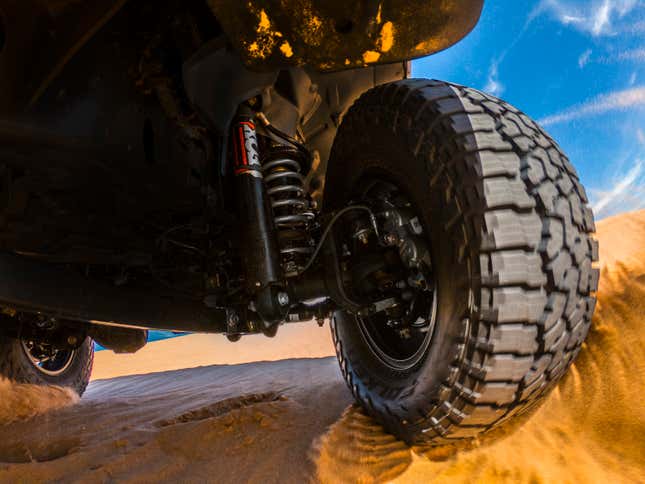
Among those edits are Fox 2.5-inch internal bypass shocks with external reservoirs (the fronts are remote, the rears are not—I’ll describe this more below), front hydraulic jounce bumpers (Those are also from Fox, and their job is to damp the impact when the suspension has reached the end of its upward travel), a one-inch suspension lift in the front only, and frame and axle reinforcements.
I asked Brandon Girmus, the Jeep Gladiator’s brand manager about those frame and axle reinforcements, which you can see illustrated on the naked chassis on the floor of the Chicago Auto Show (shown in the TLF Truck video below). He told me that, for the frame, overall thickness stays the same, though there’s some “additional welding for added strength” from roughly the Gladiator’s B-pillars rearward.
You can see in the screenshot below, painted in silver, the changes to the rear part of the “JT” Gladiator’s chassis. Notice that the shock and spring mounts are the same as those on a standard Gladiator, but the Mojave gets that reinforced frame (again, just added welds), stronger jounce bumper brackets, new springs, new Fox shocks, and a thicker track bar (not shown below).
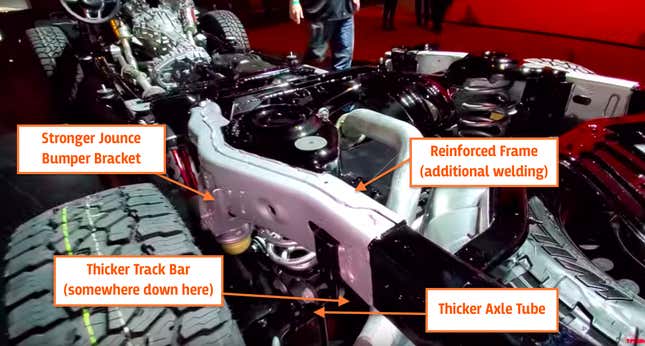
In the front, there’s there are also new Fox shocks and unique, one-inch taller springs, which act as a “leveling kit more or less with the goal of increasing jounce travel up front,” Girmus told me. The shocks have their reservoirs mounted remotely, just behind the silver front skid plate (which is the same as that on the Rubicon, only silver).
Jeep describes the benefits of the Fox shocks in its press release, writing:
The FOX shocks contain internal passages that allow fluid to bypass the piston through regulated ports as it moves through the suspension travel. The result is a predictable ride over normal off-road driving conditions, with the ability to ramp up damping force in extreme use.
Front and rear external shock reservoirs keep shock fluid cool, preventing shock fade during long runs through the hot desert at high speed. Military-grade suspension fluid maintains performance at extreme temperatures and is the same fluid used in off-road racing shocks.

Continuing our look at the front of the chassis, you’ll notice the spring cup painted silver. That means it’s new, and apparently 0.2 millimeters thicker than the one on the standard Gladiator, plus it contains that Fox hydraulic jounce bumper, which FCA says can “provide increased damping performance and bottom-out control in the last few inches of suspension travel.”
The shock mounts on the frame are also stronger, as are the upper control arms reaching to the front Dana 44 axle, which gets its own tougher shock mounts and also cast-iron knuckles in place of the non-Mojave Gladiator’s cast aluminum ones.
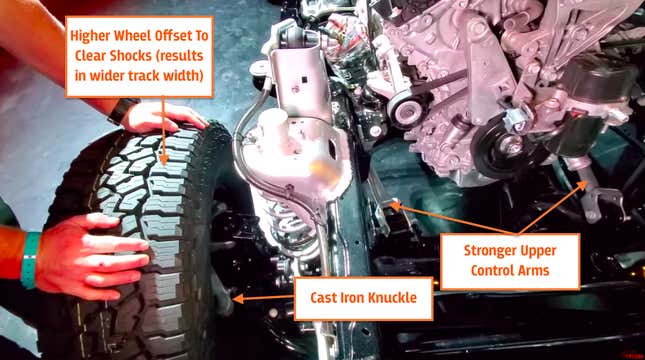
Speaking of the axles, both the front and rear are Dana 44s with 4:10 differentials. The rear—which actually has a thicker tube than the most-capable Rubicon model—gets an electronic locker, while the front makes do with a “brake-lock differential” (it’s an open diff and uses the brakes to get torque to the wheel with the most traction).
The tires are the same as those found on a Gladiator Rubicon: 33-inch Falken Wildpeak all-terrain tires on special wheels with 7.5 millimeters of additional offset over non-Mojave wheels to clear the Fox shocks, resulting in a roughly 0.5-inch wider track width.
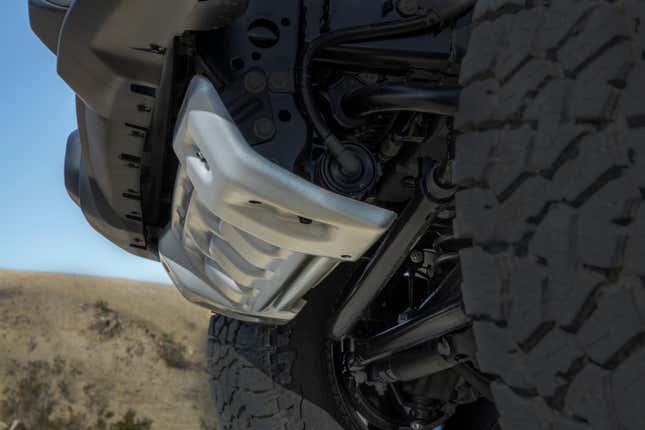
Other off-road attributes worth mentioning include the non-Rubicon Gladiator’s Command-Trac part-time four-wheel drive transfer case with a 2.72 low-range ratio, as well as the ability to activate the rear locker in high range to allow for additional rear-end traction in high-speed conditions.
As for geometry, the Mojave’s 44.7-degree approach angle and 20.9-degree breakover angle are slight improvements (less than one degree) over the Gladiator Rubicon’s, as is the 11.6-inches of overall ground clearance (up 0.5 inches). The dune truck’s taller nose means the 25.5 degree departure angle is down half a degree from Rubicon.
The Gladiator Mojave also has “sand slider side rails” to protect the rocker panels and to help the huge-bellied truck to crest sand mounds, and on the inside, the seats get more aggressive side bolsters to prevent you from sliding out of your seat while blasting through dunes.
The Mojave’s max payload rating is 1,200 pounds, and the towing capacity is 6,000—these are both with the optional eight-speed automatic transmission bolted to the 285 horsepower Pentastar V6. A six-speed manual is standard, and while it’s not a great example of a stick shift, I still think it’s worth choosing over the auto. Its towing capacity is 4,500 pounds, and carries the same load as the automatic—1,200 pounds.
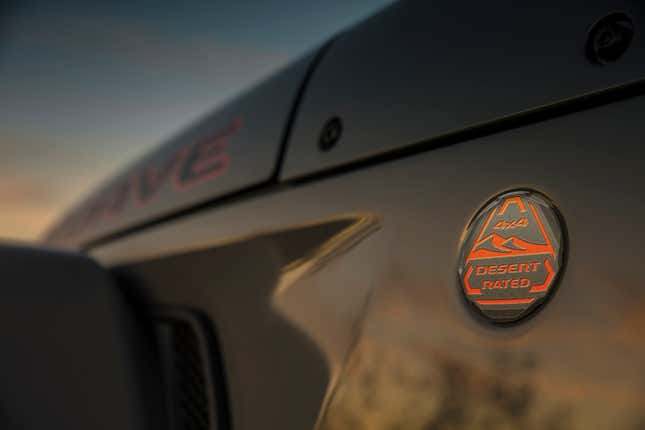
The Jeep Gladiator Mojave is the first Jeep with a “Desert Rated” badge on it, and while I think it and the “Trail Rated” badge are just silly marketing gimmicks (the sad, sad Jeep Patriot was “Trail Rated,” after all), it is worth mentioning what the badge means according to Fiat Chrysler.
Girmus told me to think of “Desert Rated” as a cousin to Trail Rating, which certifies that vehicles meet metrics encompassed by five key categories: Traction, articulation, water fording, ground clearance, and maneuverability.
“Desert rating,” he told me, “is kind of similar, but we’ve tweaked a few things to attributes that we see as being critical to higher speed off-road desert performance.”
“Probably the most important one is ride control and stability,” he said, pointing out that the Fox shocks and jounce bumpers help reduce pitching and rolling in high-speed desert maneuvering. In addition to ride control and stability, the other categories that go with “Deserted Rated” are traction, ground clearance, and maneuvering—common with “Trail Rating.” But then there’s something called “desert prowess,” whose goal is apparently to “[make] sure the vehicle can withstand the environment that has high heat or a lot of dust or sand.” The point, here, Girmus points out, is that Fiat Chrysler engineers created special tests to validate that truck’s desert-running capabilities meet the goals encompassed by these categories.
And unique tests are a big deal because slamming axles against jounce bumpers with a heavy truck like a Gladiator bombs over dunes can be tough on a machine. “Doing that repeatedly over lots and lots of cycles—it takes its toll on the suspension,” Girmus told me.
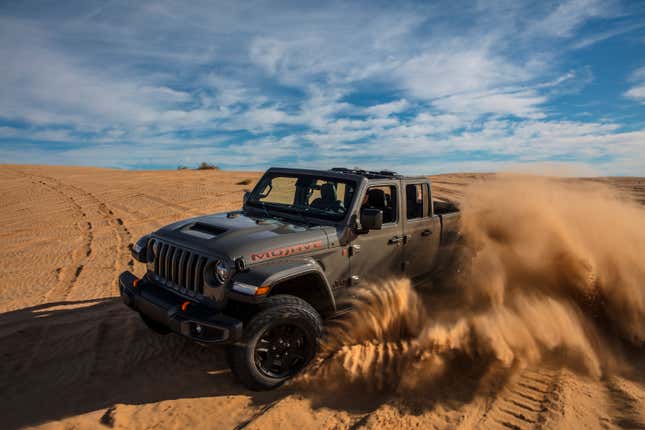
So with the new Gladiator Mojave, you’ve basically got a moderately beefed-up Gladiator meant for desert running and with a factory warranty. Is a heavy, unsprung solid axle the best setup for high-speed driving over uneven terrain? Definitely not, but I can still see how this could be appealing to some, though I bet it won’t be cheap.